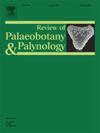Dynamics of Yunnan pine (Pinus yunnanensis) forest since the Last Glacial Maximum in central Yunnan, SW China
IF 1.7
3区 地球科学
Q2 PALEONTOLOGY
引用次数: 0
Abstract
In recent decades, the influence of climate change and human activities on forests intensified, however, their relative impacts on forest ecosystems remain ambiguous. It is thus essential to elucidate the effects of climate change and human disturbances on the dynamics of different forests. Here we selected the forest of Yunnan pine (YNP) (Pinus yunnanensis), an endemic tree species in Southwest China as an instance, to examine its dynamics since the Last Glacial Maximum (LGM) in central Yunnan where it predominantly occurs, using fossil Pinus pollen percentages and its estimated plant abundances in four lake catchments, central Yunnan. Our study reveals that the dynamics of YNP forests (YNPFs) were principally associated with climatic conditions at 20,000–2500 cal. a BP, whereas the dynamics of YNPFs after 2500 cal. a BP were significantly affected by human activities such as agriculture as well as the extraction and processing of mineral resources in central Yunnan. A long-term and big deforestation occurred at 2500–800 cal. a BP, which was caused by human activities. The restoration of YNPFs in central Yunnan after 800 cal. a BP was predominantly attributed to the natural succession of the secondary vegetation, and reforestation with the aid of ecological protection policies at the end of the 20th century has made its contribution to the recovery of YNPFs in recent decades. Climatic conditions driven by monsoon intensity and seasonal insolation as well as human activities are major factors controlling the dynamics of YNPFs in central Yunnan. Especially, the impact of human activities on YNPFs became more pronounced over the past 2500 years. Our findings not only provide a reference for understanding the interrelationships among forests, ecological environments, climate change, and human activities in central Yunnan, but also offer scientific data for making sustainable forest management policies and ecological conservation strategies.
求助全文
约1分钟内获得全文
求助全文
来源期刊
CiteScore
3.50
自引率
21.10%
发文量
149
审稿时长
6 months
期刊介绍:
The Review of Palaeobotany and Palynology is an international journal for articles in all fields of palaeobotany and palynology dealing with all groups, ranging from marine palynomorphs to higher land plants. Original contributions and comprehensive review papers should appeal to an international audience. Typical topics include but are not restricted to systematics, evolution, palaeobiology, palaeoecology, biostratigraphy, biochronology, palaeoclimatology, paleogeography, taphonomy, palaeoenvironmental reconstructions, vegetation history, and practical applications of palaeobotany and palynology, e.g. in coal and petroleum geology and archaeology. The journal especially encourages the publication of articles in which palaeobotany and palynology are applied for solving fundamental geological and biological problems as well as innovative and interdisciplinary approaches.

 求助内容:
求助内容: 应助结果提醒方式:
应助结果提醒方式:


